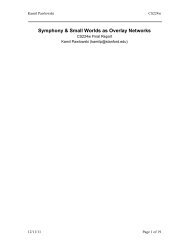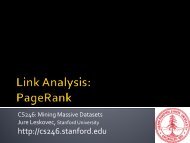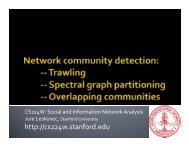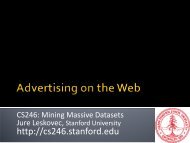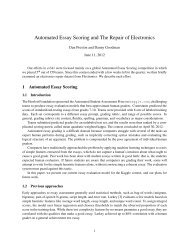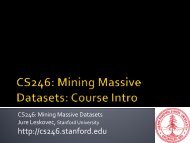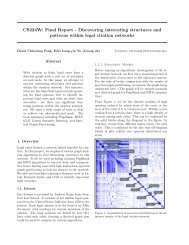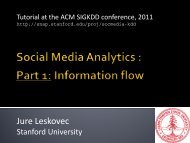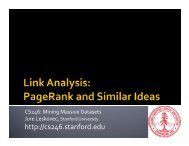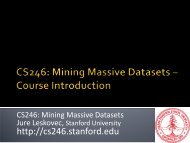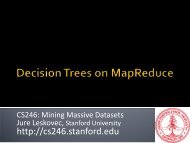Empirical Analysis of an Evolving Social Network - Science
Empirical Analysis of an Evolving Social Network - Science
Empirical Analysis of an Evolving Social Network - Science
You also want an ePaper? Increase the reach of your titles
YUMPU automatically turns print PDFs into web optimized ePapers that Google loves.
REPORTS<br />
90<br />
Fig. 3. <strong>Network</strong>-level<br />
properties over time, for<br />
three choices <strong>of</strong> smoothing<br />
window t 0 30 days<br />
(dashes), 60 days (solid<br />
lines), <strong>an</strong>d 90 days<br />
(dots). (A) Me<strong>an</strong> vertex<br />
degree bkÀ. (B) Fractional<br />
size <strong>of</strong> the largest<br />
component S. (C) Me<strong>an</strong><br />
shortest path length in<br />
the largest component<br />
L. (D) Clustering coefficient<br />
C.<br />
Fig. 4. Stability <strong>of</strong> degree<br />
distribution <strong>an</strong>d individual<br />
degree r<strong>an</strong>ks. (A)<br />
Degree distribution in<br />
the inst<strong>an</strong>t<strong>an</strong>eous network<br />
at day 61, logarithmically<br />
binned. (B) Same<br />
at day 270. (C) The<br />
Kolmogorov-Smirnov<br />
statistic D comparing degree<br />
distribution in the<br />
inst<strong>an</strong>t<strong>an</strong>eous network at<br />
day 61 <strong>an</strong>d in subsequent<br />
daily approximations.<br />
(D) Dissimilarity<br />
coefficient for degree<br />
r<strong>an</strong>ks z 0 1–r S 2 ,where<br />
r S is the Spearm<strong>an</strong> r<strong>an</strong>k<br />
correlation between individual<br />
degrees at day 61 <strong>an</strong>d in subsequent approximations. z varies between 0 <strong>an</strong>d 1 <strong>an</strong>d<br />
measures the proportion <strong>of</strong> vari<strong>an</strong>ce in degree r<strong>an</strong>ks that c<strong>an</strong>not be predicted from the r<strong>an</strong>ks in<br />
the initial network.<br />
data set except during natural spells <strong>of</strong> reduced<br />
activity, such as winter break (Fig. 4C).<br />
On the other h<strong>an</strong>d, as Fig. 4D illustrates, individual<br />
r<strong>an</strong>ks ch<strong>an</strong>ge subst<strong>an</strong>tially over the<br />
duration <strong>of</strong> the data set. Analogous results<br />
(27) apply to the concept <strong>of</strong> Bweak ties[ (13):<br />
The distribution <strong>of</strong> tie strength in the network<br />
is stable over time, <strong>an</strong>d bridges are, on<br />
average, weaker th<strong>an</strong> embedded ties Econsistent<br />
with (13)^. However, they do not retain<br />
their bridging function, or even remain weak,<br />
indefinitely.<br />
Our results suggest that conclusions<br />
relating differences in outcome measures<br />
such as status or perform<strong>an</strong>ce to differences<br />
in individual network position (14) should be<br />
treated with caution. Bridges, for example,<br />
may indeed facilitate diffusion <strong>of</strong> information<br />
across entire communities (13). However,<br />
their unstable nature suggests that they<br />
are not Bowned[ by particular individuals<br />
indefinitely; thus, whatever adv<strong>an</strong>tages they<br />
confer are also temporary. Furthermore, it is<br />
unclear to what extent individuals are capable<br />
<strong>of</strong> strategically m<strong>an</strong>ipulating their positions<br />
in a large network, even if that is<br />
their intention (14). Rather, it appears that<br />
individual-level decisions tend to Baverage out,[<br />
yielding regularities that are simple functions<br />
<strong>of</strong> physical <strong>an</strong>d social proximity. Sharing focal<br />
activities (10) <strong>an</strong>d peers (26), for example,<br />
greatly increases the likelihood <strong>of</strong> individuals<br />
becoming connected, especially when these<br />
conditions apply simult<strong>an</strong>eously.<br />
It may be the case, <strong>of</strong> course, that the individuals<br />
in our population—mostly students<br />
<strong>an</strong>d faculty—do not strategically m<strong>an</strong>ipulate<br />
their networks because they do not need to, not<br />
because it is impossible. Thus, our conclusions<br />
regarding the relation between local <strong>an</strong>d global<br />
network dynamics may be specific to the<br />
particular environment that we have studied.<br />
Comparative studies <strong>of</strong> corporate or military<br />
networks could help illuminate which features<br />
6 JANUARY 2006 VOL 311 SCIENCE www.sciencemag.org<br />
<strong>of</strong> network evolution are generic <strong>an</strong>d which are<br />
specific to the cultural, org<strong>an</strong>izational, <strong>an</strong>d<br />
institutional context in question. We note that<br />
the methods we introduced here are generic <strong>an</strong>d<br />
maybeappliedeasilytoavariety<strong>of</strong>othersettings.<br />
We conclude by emphasizing that underst<strong>an</strong>ding<br />
tie formation <strong>an</strong>d related processes in<br />
social networks requires longitudinal data on<br />
both social interactions <strong>an</strong>d shared affiliations<br />
(4, 6, 10). With the appropriate data sets, theoretical<br />
conjectures c<strong>an</strong> be tested directly, <strong>an</strong>d<br />
conclusions previously based on cross-sectional<br />
data c<strong>an</strong> be validated or qualified appropriately.<br />
References <strong>an</strong>d Notes<br />
1. P. S. Dodds, D. J. Watts, C. F. Sabel, Proc. Natl. Acad. Sci.<br />
U.S.A. 100, 12516 (2003).<br />
2. J. M. Kleinberg, Nature 406, 845 (2000).<br />
3. T. W. Valente, <strong>Network</strong> Models <strong>of</strong> the Diffusion <strong>of</strong><br />
Innovations (Hampton Press, Cresskill, NJ, 1995).<br />
4. P. Dorei<strong>an</strong>, F. N. Stokm<strong>an</strong>, Eds., Evolution <strong>of</strong> <strong>Social</strong><br />
<strong>Network</strong>s (Gordon <strong>an</strong>d Breach, New York, 1997).<br />
5. P. Lazarsfeld, R. Merton, in Freedom <strong>an</strong>d Control in<br />
Modern Society, M. Berger, T. Abel, C. Page, Eds. (V<strong>an</strong><br />
Nostr<strong>an</strong>d, New York, 1954), pp. 18–66.<br />
6. M. McPherson, L. Smith-Lovin, J. M. Cook, Annu. Rev.<br />
Sociol. 27, 415 (2001).<br />
7. J. A. Davis, Am. J. Sociology 68, 444 (1963).<br />
8. T. M. Newcomb, The Acquaint<strong>an</strong>ce Process (Holt Rinehart<br />
<strong>an</strong>d Winston, New York, 1961).<br />
9. P. M. Blau, J. E. Schwartz, Crosscutting <strong>Social</strong> Circles<br />
(Academic Press, Orl<strong>an</strong>do, FL, 1984).<br />
10. S. L. Feld, Am. J. Sociology 86, 1015 (1981).<br />
11. J. S. Colem<strong>an</strong>, Sociol. Theory 6, 52 (1988).<br />
12. A. Rapoport, Bull. Math. Biophys. 15, 523 (1953).<br />
13. M. S. Gr<strong>an</strong>ovetter, Am. J. Sociology 78, 1360 (1973).<br />
14. R. S. Burt, Am. J. Sociology 110, 349 (2004).<br />
15. M. Hammer, Soc. <strong>Network</strong>s 2, 165 (1980).<br />
16. M. T. Hallin<strong>an</strong>, E. E. Hutchins, Soc. Forces 59, 225 (1980).<br />
17. M. E. J. Newm<strong>an</strong>, Proc. Natl. Acad. Sci. U.S.A. 98, 404<br />
(2001).<br />
18. S. Wasserm<strong>an</strong>, K. Faust, <strong>Social</strong> <strong>Network</strong> <strong>Analysis</strong>: Methods<br />
<strong>an</strong>d Applications (Cambridge Univ. Press, Cambridge,<br />
1994).<br />
19. M. E. J. Newm<strong>an</strong>, SIAM Review 45, 167 (2003).<br />
20. J. P. Eckm<strong>an</strong>n, E. Moses, D. Sergi, Proc. Natl. Acad. Sci.<br />
U.S.A. 101, 14333 (2004).<br />
21. C. Cortes, D. Pregibon, C. Volinsky, J. Comp. Graph. Stat.<br />
12, 950 (2003).<br />
22. P. Holme, C. R. Edling, F. Liljeros, Soc. <strong>Network</strong>s 26, 155<br />
(2004).<br />
23. B. Wellm<strong>an</strong>, C. Haythornthwaite, Eds., The Internet in<br />
Everyday Life (Blackwell, Oxford, 2003).<br />
24. N. K. Baym, Y. B. Zh<strong>an</strong>g, M. Lin, New Media Soc. 6, 299<br />
(2004).<br />
25. Materials <strong>an</strong>d methods are available as supporting<br />
material on <strong>Science</strong> Online.<br />
26. H. Louch, Soc. <strong>Network</strong>s 22, 45 (2000).<br />
27. G. Kossinets, D. J. Watts, data not shown.<br />
28. M. E. J. Newm<strong>an</strong>, S. H. Strogatz, D. J. Watts, Phys. Rev. E<br />
6402, 026118 (2001).<br />
29. We th<strong>an</strong>k P. Dodds <strong>an</strong>d two <strong>an</strong>onymous reviewers for<br />
helpful comments <strong>an</strong>d B. Beecher <strong>an</strong>d W. Bourne for<br />
assist<strong>an</strong>ce with data collection <strong>an</strong>d <strong>an</strong>onymization. This<br />
research was supported by NSF (SES 033902), the James S.<br />
McDonnell Foundation, Legg Mason Funds, <strong>an</strong>d the<br />
Institute for <strong>Social</strong> <strong>an</strong>d Economic Research <strong>an</strong>d Policy at<br />
Columbia University.<br />
Supporting Online Material<br />
www.sciencemag.org/cgi/content/full/311/5757/88/DC1<br />
Materials <strong>an</strong>d Methods<br />
References<br />
1 July 2005; accepted 29 November 2005<br />
10.1126/science.1116869



